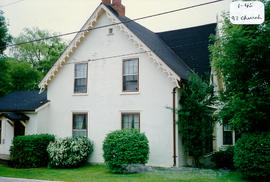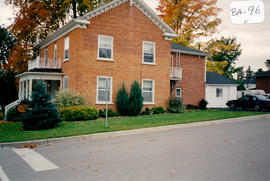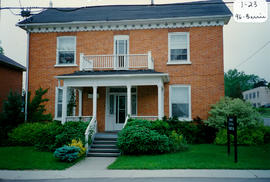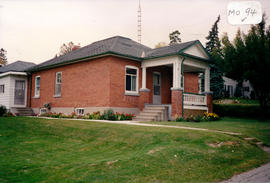99 Barrie Street- The Pringle House
- CA BWGPL GJ-HB-2017-03-10-07
- Item
- 1995
Part of George Jackson fonds
The Pringle House is located mid-block on the east side at 99 Barrie Street. It was the home of Walter Pringle, owner and manager of the first Dominion store (on Holland St.) in the 1930’s. The 1½-storey, two-bay ‘bungalow’ was built in the Arts and Crafts style. The construction of this house (and six others) was begun in 1912 by Lieutenant George Stoddart. When Stoddart went overseas during WWI, the projects were completed by builder Art Saint.
The house has a simple form with an asymmetrical façade and a rectilinear plan. It has a bell-cast roof on the centre dormer and a steeply-pitched, truncated gable roof that extends down to reduce the scale of the building. This roof also covers the raised porch and is supported on wood half posts on brick piers. The porch has a simple, wood handrail and baluster. Wood lattice encloses the underside of the porch. A wide band of windows across the front of the dormer emphasizes the horizontal lines and the massing of the house. The building has wide window openings with low floor to ceiling heights. Ground-floor and basement windows and the front door are set into segmented, arched openings with concrete sills. Second-storey windows are offset from the ground-floor windows and have plain, wood sills and trim. The mix of exterior cladding materials and the wood fascia band (expressing the line of the floor structure between the ground and second floors) is common to this style. There are returned eaves at the porch roof. The house has wood frame construction with brick masonry cladding, painted wood shingles on the dormer, and a painted, concrete foundation. The front ground-floor and second-floor windows are not original. According to the 2000 inventory, the house is in good condition with many original features that have been maintained well. (1, 2, 3)
George Jackson










